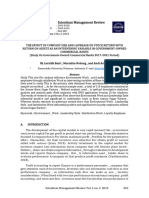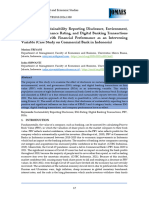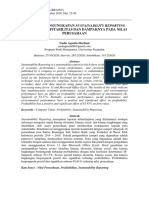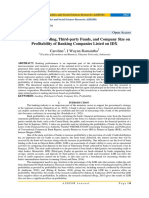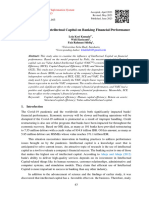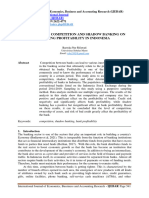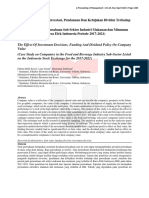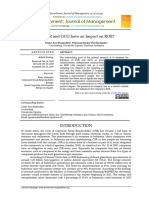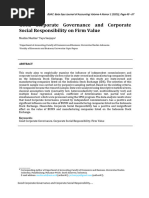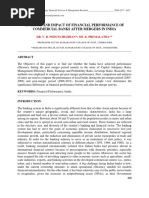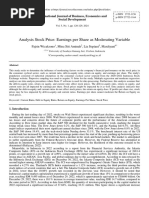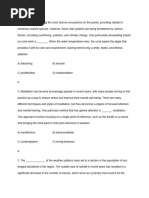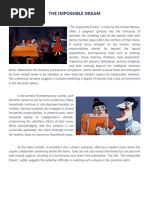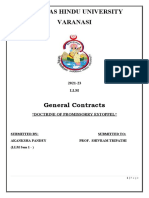1211-Article Text-6260-1-10-20230630
1211-Article Text-6260-1-10-20230630
Uploaded by
suci wulandariCopyright:
Available Formats
1211-Article Text-6260-1-10-20230630
1211-Article Text-6260-1-10-20230630
Uploaded by
suci wulandariCopyright
Available Formats
Share this document
Did you find this document useful?
Is this content inappropriate?
Copyright:
Available Formats
1211-Article Text-6260-1-10-20230630
1211-Article Text-6260-1-10-20230630
Uploaded by
suci wulandariCopyright:
Available Formats
International Journal of Finance Research
e-ISSN 2746-136X
Vol. 4 No. 2, June 2023
Disclosure of Green Banking, Profitability and
Company Size on Company Value in Banking in
Indonesia
Asti Pratiwi1, Abdul Basyith*2, Ervita Safitri3
1,2,3
Program Studi Manajemen
Fakultas Ekonomi dan Bisnis
Universitas Muhammadiyah Palembang, Sumatera Selatan, Indonesia
*
Corresponding author: basyith_feump@yahoo.com,
astipratiwi12@gmail.com1
Article Information:
Received: June 01, 2023, Accepted: June 15, 2023, Published: June 30, 2023
Abstract
This study aims to determine the effect of green banking disclosures, profitability and firm size on firm
value. The sample used was 11 samples with 55 observations using purposive sampling technique. The
data used is secondary data, with the data collection method using content analysis. The analysis
technique used is multiple linear regression analysis. The results of the analysis prove (1) disclosure of
green banking, profitability and firm size has a positive and significant effect on firm value, (2)
disclosure of green banking has a negative and significant effect on firm value, (3) profitability has a
positive and significant effect on firm value, and (4) company size has a positive and insignificant effect
on firm value.
Keywords: Disclosure of Green Banking, Profitability, Firm Size, Firm Value
JEL Codes:
How to Cite:
Pratiwi, A., Basyith, A., Safitri, E. (2023). Disclosure of Green Banking, Profitability and
Company Size on Company Value in Banking in Indonesia. International Journal of Finance
Research, 4(2). 115 - 127. DOI: https://doi.org/10.47747/ijfr.v4i2.1211
1. Introduction
Current environmental problems indirectly affect the Indonesian economy. The current
economy has created competition between companies which makes it even more intense to
improve performance so that company goals are achieved. The main goal of the company, one
of which is to increase the value of the company to generate profits. An increase in company
value due to high stock prices will make the market believe in the company's performance and
Published by: 115
International Journal of Finance Research
e-ISSN 2746-136X
Vol. 4 No. 2, June 2023
prospects in the future (Rudangga & Sudiarta, 2017). Where the value of the company is a very
important aspect because it can reflect the reputation and performance of a company. The value
of a type of company can influence or be influenced by economic conditions because economic
activity always involves many parties, one of which is banking. Banks are directly involved
with many business sectors through their financing activities (Wijaya et al., 2021). The purpose
of a company being established is to get large profits and maximize firm value. In other words,
maximizing the value of the company means maximizing the main goal of a company. If the
stock value is higher, the company's value will be better, and can increase market confidence
in the company's performance. Shareholder and corporate wealth is represented by the market
price of the stock, which reflects investment, financial and wealth management decisions. The
stock price of a company is formed between buyers and sellers when trading occurs, which is
known as the company's market value because the stock price reflects the company's value
(Muzaki, 2022). Some factors that can affect the value of the company include profitability and
company size, where profitability is an important factor in financial management and can be
interpreted as an entity by utilizing the assets owned by the company. Profitability is to show
the company's success in generating profits. Potential investors will look closely at the smooth
running of a company and its ability to make a profit, the better the profitability, the better the
company's ability to earn high profits (Anggraeni et al., 2019). The value of a company is said
to be affected by its size because larger companies have an easier time finding sources of
funding with which to achieve their goals. On the other hand, because corporations have little
danger in carrying out their obligations, they will generate large amounts of debt (Indriyani,
2017). According to Tiara & Jayanti, (2022) Total assets represent company size, which can
be determined by looking at the number of employees, total assets, stock market value, and
other factors. The value of the company can increase if its total assets exceed all of its liabilities.
Although environmental issues should be a major concern given the current environmental
damage. To overcome these problems, the green economy concept continues to be pursued so
that economic activities can reduce their impact on the environment. One form of the green
economy concept is known as green banking. According to Budiantoro (2015), Green banking
is a banking effort to prioritize the fulfillment of sustainability in financing (credit distribution)
or operational activities. Sustainable fulfillment is defined as growth that prevents future
declines in production capacity. The availability of resources, including natural, human,
technological and other resources, is very important for this production capacity. Meeting the
needs of the present without compromising the capacity of future generations to do the same is
known as sustainable development. Banks are a source of funding for industry, whose business
activities often have an impact on the environment. Thus, now banks are also required to have
an environmentally friendly commitment, one of which is by implementing green banking. In
principle, green banking is an effort to strengthen banking management capabilities related to
environmental and social issues. For example, by increasing the bank's portfolio in financing
the renewable energy industry, organic farming, and so on. There are four banks that are widely
perceived as having implemented green banking principles. In first place is a private bank,
namely Bank Central Asia (BCA) which is considered to have implemented green banking by
25.7%. After that there are three state-owned banks, namely Bank Rakyat Indonesia (BRI) with
a percentage of 23.7%, Bank Negara Indonesia (BNI) 12.6%, and Bank Mandiri 12.1%.
Meanwhile, other banks are not widely perceived as green banking actors, with a percentage
of each below 2%. (Databokskatadata.co.id, 2022). On the other hand, companies that are
digital banks, get poor stock performance where there is a decline in digital bank shares. Based
on the data, there are three banks listed on the Indonesian Stock Exchange (IDX), namely PT
Published by: 116
International Journal of Finance Research
e-ISSN 2746-136X
Vol. 4 No. 2, June 2023
bank CIMB Niaga Tbk (BNGA), PT bankKB Bukopin Tbk (BBKP), and PT bank OCBC NISP
Tbk (NISP).
Figure I. Digital Bank Stock Performance 2020-2021
Source: Data Processing
There are 3 banks that have the same pattern of decline, these banks are PT bank CIMB Niaga
Tbk (BNGA), PT bankKB bukopin Tbk (BBKP), and PT bank OCBC NISP Tbk (NISP). Chart
1 shows the performance of digital bank shares from 2020 to 2021. The three banks are
predicted to experience the deepest decline so far this year. BNGA bank shares in 2020 reached
a price of Rp. 995 and will experience a decrease in 2021 at a price of Rp. 965. PT bankKB
bukopin Tbk (BBKP) share performance in 2020 is Rp. 575, and decreased to Rp. 270 in 2021.
Then PT bank OCBC NISP Tbk (NISP) in 2021 will reach a price of Rp. 820 and in 2021 it
will decrease by Rp. 670. The decline in banking shares is due to a lack of public trust in banks
in Indonesia at this time because banks have not implemented many environmentally friendly
concepts even though bank shares have fallen, financial performance has actually improved.
Even though banks are considered to have to pay attention to environmental aspects in all their
business activities, some stakeholders think that banks do not have a significant impact on the
environment. disclosure of bank efforts in protecting the environment or the application of
green banking provides added value to the bank's reputation, but does not have a positive
impact on company profits as does financial performance.
Previous research was conducted by Winarto & Nurhidayah (2021), with research results
showing that green banking has a positive effect on firm value. Meanwhile, the research
conducted by Muzaki (2022) obtained research results which showed that green banking
disclosures had no effect on company value. Besides that, in Mumtazah & Purwanto's research,
2020, it shows that disclosure of green environment has a positive but not significant effect on
company value. The results of research from Muharramah & Hakim (2021), show that
company size affects company value. While profitability does not affect the value of the
company. As well as research conducted by Sutama & Lisa (2018), shows that profitability has
a significant positive effect on company value.
Published by: 117
International Journal of Finance Research
e-ISSN 2746-136X
Vol. 4 No. 2, June 2023
Based on the phenomena and problems above, the purpose of this study was to determine the
effect of green banking disclosures, profitability and firm size on firm value in banking in
Indonesia. As well as the benefits for all banking companies in Indonesia, especially regarding
the disclosure of green banking, profitability and company size on firm value.
2. Literature Review
Research by Tiara & Jayanti (2022), with the title of the influence of green banking, firm age
and firm size on firm value. The results show that the green banking variable has no significant
effect on firm value, firm age shows a significant negative effect on firm value, firm size has a
significant positive effect on firm value and the three variables namely green banking, firm age
and firm size simultaneously have a significant effect on firm value The equation of this study
is that the independent variables both use green banking and company size. The difference in
this study lies in the firm age variable.
Karyani & Obrien (2020), with the title Green Banking and Performance: The Role of Foreign
and Public Ownership. The dependent variable used is bank performance, while the
independent variable used is green banking. This research also uses moderating variables,
namely foreign ownership and public ownership. The results of this study indicate that green
banking practices have a negative effect on profitability, while green banking practices have a
positive effect on bank value. The moderating variable of public ownership strengthens the
negative effect of the effect of green banking on profitability, while the variable of foreign
ownership weakens the positive effect of the positive effect of green banking practices on
banking value. The equation in this study lies in the independent variables of green banking
and profitability. The difference in this study uses moderating variables, namely foreign
ownership and public ownership.
Muharramah & Hakim (2021), with the title influence of firm size, leverage, and profitability
on firm value. The results of this study indicate that firm size affects firm value. While leverage
and profitability do not affect firm value. The equation of this study lies in the independent
variables firm size, profitability and firm value as the dependent variable. The difference in this
study lies in the leverage variable.
Research from Winarto, & Nurhidayah, (2021) with the title the effect of green banking
disclosure on corporate value at public banks um sharia in Indonesia. The results of the study
indicate that there is a significant positive effect of green banking disclosure on firm value in
Islamic banking. The equation of this study is that both use the green banking disclosure
variable as the independent variable and the firm value variable as the dependent variable. The
difference in this study is that the object of research was conducted at Islamic commercial
banks while this research was conducted at banking companies in Indonesia that are listed on
the IDX.
Research by Simanungkalit & Mayangsari, (2020) with the title of the effect of gender
diversification, managerial ownership and green banking on the value of banking companies.
The results of this study indicate that board of commissioners gender diversification and
managerial ownership have a negative effect on firm value, while green banking has no effect
on firm value. Firm size is not proven to moderate the effect of board of commissioners gender
diversification, managerial ownership, and green banking on firm value. The equation in this
study is the green banking variable as the independent variable and firm value as the dependent
variable. The difference in this research is the object used in 2018-2021 while this research is
in 2017-2021.
Published by: 118
International Journal of Finance Research
e-ISSN 2746-136X
Vol. 4 No. 2, June 2023
Research by Lugina Kurniawan, (2021) with the title influence of financial performance on
green banking disclosure with a control mechanism as a moderating variable. The results of the
study show that financial performance has a direct positive effect on green banking disclosure.
Of the three elements of the control mechanism, only the variable public ownership moderates
the positive effect of performance on green banking disclosure. Meanwhile, the board of
commissioners and the audit committee did not moderate the effect of financial performance
on green banking disclosures at banking companies listed on the IDX during the study period.
The equation in this study lies in the independent variable, namely green banking disclosure.
while the difference in this study lies in the board of commissioners and audit committee
variables.
Romli & Zaputra's research, (2022) with the title the influence of the implementation of green
banking, corporate social responsibility on firm value in banking companies listed on the IDX.
Based on the test results, it was found that the green banking implementation variable has a
negative influence on company value. While the variable disclosure of corporate social
responsibility has no effect on firm value. The equation in the study lies in the independent
variable, namely green banking and firm value as the dependent variable. The difference in this
research is corporate social responsibility. Research by Mumtazah & Purwanto, (2020) with
the title analysis of the effect of financial performance and environmental disclosure on
company value. The results of the study show that environmental disclosures made by banks
do not have a significant effect on firm value because people think that banks do not have a
direct impact on the environment like other industries. The equation in this study lies in the
independent variables, namely disclosure of green banking and firm value as the dependent
variable. The difference in this study lies in the financial performance variable.
Research conducted by Zhafran Mufid Galyani, (2022) entitled Determination of factors that
influence firm value in banking companies. This study aims to analyze the effect of corporate
social responsibility (x1), green banking (x2), non-performing loans (x3), and loan to deposit
ratio (x4) on the value of banking companies. The results show that corporate social
responsibility has a positive influence on the value of the company. Then non-performing loans
have a negative influence on company value. Meanwhile, green banking and loan to deposit
ratio have no effect on firm value. The equation in this study lies in the independent variables
both using green banking variables and firm value as the dependent variable. The difference in
this study lies in the variables of corporate social responsibility, non-performing loans and loan
to deposit ratio.
Research by Khan, Bose, Sheehy & Quazi, (2021) with the title green banking disclosure, firm
values, and the moderating role of a contextual factor a distinctive regulatory setting. The
results of the study show that green banking disclosure has a positive effect on the overall firm
value. The equation in the study is that both use the green banking disclosure variable as the
independent variable. The difference in this study is the non-performing loan variable and this
study uses a moderating variable.
Handajani & Mataram Research, n.d. (2021) with the title corporate governance and green
banking disclosure: studies on banks in Indonesia. The results of this study indicate a trend of
increasing green banking disclosures during the observation period. This study also found that
there is a significant effect of the size of the board of commissioners on the disclosure of green
banking practices, but the existence of independent commissioners and institutional ownership
Published by: 119
International Journal of Finance Research
e-ISSN 2746-136X
Vol. 4 No. 2, June 2023
has no effect. The equation in this study is that they both use green banking disclosure variables.
The difference in this study is using corporate governance.
Research by Sutama & Lisa, (2018) the effect of leverage and profitability on company value.
Statistical test results show that the variable profitability has a very strong relationship with
firm value. Partially, profitability turns out to have a significant positive effect on firm value.
This means that the higher the profitability of each, the higher the value of the company.
Likewise, the profitability variable simultaneously has a significant positive effect on firm
value, meaning that the higher the profitability, the higher the firm value. The equation in this
study lies in the independent variables, namely using the variable profitability and firm value
as the dependent variable. The difference in this study lies in the leverage variable.
Research by Hossain et al., (2020) entitled The Effects of Green Banking Practices on Financial
Performance of Listed Banking Companies in. The results of this study found that there is a
positive relationship between green banking practices and financial performance. The findings
resulting from this study can serve as appropriate guidelines for bank regulators to take
effective decisions regarding environmental issues and thus make social contributions, and
after all, play an important role in economic growth. The equation in this study is that the
independent variables both use green banking variables. While the difference in this study is
the dependent variable using financial performance variables.
Research by Irawan & Kusuma, (2019) with the title influence of capital structure and company
size on company value. The results of this study indicate that capital structure has no effect on
firm value, while firm size has a negative and significant effect on firm value. The equation in
this study lies in the independent variables, namely the independent variables of firm size and
firm value as independent variables. The difference in this study lies in the capital structure
variable.
Prawirasasra research, (2015) with the title Analysis of the relationship of environmental
performance and firm value. In International Conference on Economics and Banking. The
results of this study indicate a positive relationship between environmental performance and
firm value. The equation in this study is the independent variable, namely the variable
environmental performance and company value as the dependent variable. While the difference
in this study is the period used in the 2011-2013 study.
3. Research Methods
The type of research used in this research is quantitative, because the data used in the research
is in the form of numerical data and the research analysis uses statistical data. The quantitative
research method is to obtain a significant relationship between research variables. Where is the
disclosure of green banking (X1), profitability (X2), and firm size (X3) to firm value (Y), with
the operational research variables as follows:
Table 1. Operational Research Variables
variable Definition Variable Indicator Scale
the price that can be sold with a price agreement
Firm value Tobin Ratio
that has been reached by a company that will be
s’Q
paid by investors or buyers at the price that will
be sold.
Disclosure of disclosure to the public regarding the company's GBDI Ratio
Published by: 120
International Journal of Finance Research
e-ISSN 2746-136X
Vol. 4 No. 2, June 2023
green banking environmentally friendly activities.
Profitability show the company's ability to increase profits R
Ratio
through profits generated from sales and ROA
investment income to see the company's
efficiency.
L
ROA Ratio
Ln Size
Total asset
Firm size
This research was conducted at banking companies listed on the Indonesia Stock Exchange
that issue annual reports and/or sustainability reports. The population in this study includes 47
banking sector companies listed on the IDX in 2017-2021. Sampling was carried out using a
purposive sampling technique, while 11 banking companies were taken as samples, which met
the criteria for issuing sustainability reports consecutively during 2017-2021. The data used in
this research is secondary data obtained from financial reports, annual reports, and and
sustainability reports issued by banking companies listed on the Indonesian stock exchange for
the period 2017-2021 on the websites of related companies. The analysis techniques used
include financial analysis, descriptive statistical data analysis, multiple regression analysis and
hypothesis testing.
4. Results And Discussion
4.1. Descriptive Statistics
Data Analysis Test With a total sample of 11 banking companies x 5 observations (2017-2021),
the total sample is 55 observations. The research data shows that the variables of profitability,
firm size, and firm value show a smaller standard deviation when compared to the mean
(mean), which means that the distribution of research data is quite varied. Except for the green
banking disclosure variable which has a standard deviation that is larger than the average
(mean).
Tabel 2. Hasil Analisis Deskriptif
N Range Minimum Maximum Mean Std. Deviation
Firm Value 55 706586,791 26032,399 732619,190 193971,30190 141314,428100
Disclosure of
55 666,762 0,238 667,000 12,69529 89,860397
Green Banking
Profitability 55 0,158 -0,041 0,118 0,01677 0,022864
Ln Size 55 4,388 16,881 21,269 19,49329 1,116460
Valid N (listwise) 55
Published by: 121
International Journal of Finance Research
e-ISSN 2746-136X
Vol. 4 No. 2, June 2023
4.2. Multiple Regression Analysis
4.3.Table 3. Multiple Regression Analysis Results
Unstandardized
Coefficients
Model B Std. Error t Sig.t
1 (Constant) -404607,120 291269,673 -1,389 ,171
Disclosure of Green -460,488 228,087 -2,019 ,049
Banking
Profitability 3831082,87 889209,941 4,308 ,000
4
Ln Size 27711,037 14967,216 1,851 ,070
R ,566
R Square ,321
Adjusted R Square ,281
Df 3
51
F 8,032
Sig.F ,000
Based on the table above, it can be arranged into an equation, as follows:
Y (Company Value) = -404,607.120 -460.488X1 +3,831,082.874X2 + 27,711.037X3
Based on the multiple linear regression equation above, it is known that the constant value is -
404,607.120, meaning that if the independent variables of Green Banking Disclosure,
Profitability and Company Size are considered constant, it can be predicted that the company
value is -404,607.120.
The Green Banking Disclosure Coefficient (β1) is -460.488, this figure indicates that every one
percent increase in GDBI will be followed by a decrease in Tobin's Q of -4.60488%.
Profitability Coefficient (β2) 3,831,082.874, this figure shows that every one percent increase
in ROA will be followed by an increase in Tobin's Q of 38310.83%.
Firm Size Coefficient (β3) 27,711.037, this figure shows that every one percent increase in LN
will be followed by an increase in Tobin's Q of 27,711.037.
Hypothesis testing Regression Model Fit Test Results Based on the results of the regression
model fit test, it shows that the value of Fcount is 8.032 > Ftable 2.786, with a sig.F level of
0.000 <0.05 (significant), then H0 is rejected and Ha is accepted, meaning that disclosure of
green banking, profitability and company size has a significant effect on value company. Slope
Test Results - Multiple Regression Analysis Based on the results of the slope test - multiple
regression analysis, it shows that the tcount value of green banking disclosure is -2.019 < ttable
2.007, with a sig.t level of 0.049 <0.05 (significant), then H0 is accepted and Ha is rejected,
meaning that green banking disclosure has no significant effect on the value of the company.
The tcount profitability is 4.308 > ttable 2.007, with a sig.t level of 0.000 <0.05 (significant),
then H0 is rejected and Ha is accepted, meaning that profitability has a significant effect on
firm value.
Published by: 122
International Journal of Finance Research
e-ISSN 2746-136X
Vol. 4 No. 2, June 2023
The tcount value of firm size is 1.851 <ttable 2.007, with a sig.t level of 0.070 > 0.05 (not
significant), then H0 is accepted and Ha is rejected, meaning that firm size has no significant
effect on firm value.
Coefficient of Determination (R2) Based on the calculation of the coefficient of determination,
it can be seen that the value of R Square (Coefficient of Determination) is 0.321 or 0.321 x
100% = 32.1%. The R Square number is 0.321, indicating the effect of green banking disclosure
variables, profitability and firm size on firm value of 32.1%. While the rest is influenced by
other variables outside of this study.
4.4. Discussion
4.4.1. Effect of Disclosure of Green Banking, Profitability and Company Size on Company
Value
Based on the research results, it is known that disclosure of green banking, profitability and
firm size has a Fcount of 8.032 > Ftable of 2.786, with a sig. F 0.000 <0.05 (significant), then
H0 is rejected and Ha is accepted, meaning that disclosure of green banking, profitability and
firm size has a significant effect on firm value.
These results explain that green banking disclosures, profitability and firm size are related to
one another in influencing firm value. Disclosure of Green Banking has an influence on
company value, because the goal with the concept of green banking is to increase the perception
of bank investors by reporting, while the goal of banking companies is to maximize the value
of the company to be achieved by the organization. Profitability has an influence on company
value, because the profitability ratio is the ratio to assess the company's ability to achieve
profits, the higher the profitability ratio, the added value will be for the company. Also, the size
of the company has an influence on the value of the company, because the size of the company
can determine the level of ease with which the company obtains funding through the capital
market, large companies tend to be considered to have high value and are considered good by
investors.
These results are in line with the theory put forward by Anggraeni et al (2019), several factors
that can affect company value include profitability and company size, where profitability is an
important factor in financial management and can be interpreted as an entity by utilizing its
assets company. Profitability is to show the company's success in generating profits. Potential
investors will look closely at the smooth running of a company and its ability to make a profit,
the better the profitability, the better the company's ability to earn high profits.
These results are supported by research conducted by Tiara & Jayanti (2022), whose research
results prove that there is a significant effect of green banking and company size on firm value.
The difference lies in previous studies that did not use the profitability variable s but using the
variable company age. This research is also supported by Murammah & Hakim (2021), with
the results of their research proving that there is a significant effect of company size and
profitability on firm value. The difference is in previous studies using green banking disclosure
variables but using leverage variables.
4.4.2. Effect of Green Banking Disclosure on Company Value
Based on the results of the study it is known that green banking disclosures have a tcount value
of -2.019 < ttable 2.007, with a sig.t level of 0.049 <0.05 (significant), then H0 is accepted and
Ha is rejected, meaning that green banking disclosures have no significant effect on firm value.
This result is reinforced by the coefficient value of -460.488 which indicates that every one
Published by: 123
International Journal of Finance Research
e-ISSN 2746-136X
Vol. 4 No. 2, June 2023
percent increase in green banking disclosures will be followed by a decrease in firm value of -
4.60488%.
These results prove that green banking disclosures have no effect on firm value. This result is
in line with the theory put forward by Budiantoro (2015), Green banking is a banking effort to
prioritize the fulfillment of sustainability in financing (credit distribution) or operational
activities. Fulfillment of sustainability is defined as development that does not contain future
production capabilities, which decreases. This production capability is highly dependent on the
availability of natural, human, technological and other resources. Sustainable development is
a process of meeting the needs of the current generation without compromising the ability of
future generations to meet their own needs.
The results of this study are in line with previous research conducted by Karyani & Obrien
(2020) which proved that green banking has a significant effect on bank values. However, there
are differences between the results of this study and previous research, which in this study
showed a negative effect between green banking disclosures on firm value, while previous
research showed a positive effect of green banking on bank values.
4.4.3. Effect of Profitability on Firm Value
Based on the research results it is known that profitability has a tcount of 4.308 > ttable of
2.007, with a sig.t level of 0.000 <0.05 (significant), then H0 is rejected and Ha is accepted,
meaning that profitability has a significant effect on firm value. This result is reinforced by a
coefficient value of 3,831,082.874, indicating that every one percent increase in profitability
will be followed by an increase in firm value of 38,310.83%.
These results prove that profitability has a positive effect on firm value. This result is in line
with the theory put forward by Kasmir (2019) that the profitability ratio is a ratio for assessing
a company's ability to achieve profits. This ratio provides a measure of the effectiveness of a
company's management. This is shown by the profit generated from sales and investment
income to see the efficiency of the company.
The results of this study are in line with previous research conducted by Muharramah & Hakim
(2021) which proved that profitability has a significant effect on company value.
4.4.4. Effect of Firm Size on Firm Value
Based on the research results it is known that company size has a tcount value of 1.851 < ttable
2.007, with a sig.t level of 0.070 > 0.05 (not significant), then H0 is rejected and Ha is accepted,
meaning that company size has no significant effect on firm value. Meanwhile, the coefficient
value of 27,711.037 for firm size is positive, indicating that every one percent increase in firm
size will be followed by an increase in firm value of 27,711.037. These results prove that firm
size has no significant effect on firm value, but there is a positive correlation between firm size
and firm value.
These results are in line with the theory put forward by Setiawan et al (2015), company size
can determine the level of ease with which a company obtains funding through the capital
market, large companies tend to more easily access funding through the capital market, then
are captured as a positive signal by investors so that decided to invest.
The results of this study are in line with previous research conducted by Muharramah & Hakim
(2021) which proved company size had a positive effect on firm value. However, there is a
difference between the results of this study and previous research, which in this study showed
Published by: 124
International Journal of Finance Research
e-ISSN 2746-136X
Vol. 4 No. 2, June 2023
no significant effect of firm size on firm value, while previous studies showed a significant
effect on firm value.
5. Conclusions
Conclusion Based on the results of the analysis and discussion that has been carried out, it can
be concluded, as follow: 1. Green banking disclosure variables, profitability and firm size have
a significant effect on firm value. 2. The green banking disclosure variable has no significant
effect on firm value. 3. The variable profitability has a significant effect on firm value. 4. The
variable firm size has no significant effect on firm value. Suggestion Based on the conclusions
above, the authors provide suggestions aimed at the good and progress of the banking sector,
as follows: 1. Disclosures of Green Banking must be increased from year to year so that they
can have a positive impact on company value, because the disclosures of Green Banking that
are reported must be consistent according to the number of existing disclosure items. 2.
Companies in the banking sector should increasingly strive to increase their profitability from
year to year, because profitability not only guarantees the progress and sustainability of the
company, but also adds value to the company. Because companies that are able to obtain the
maximum possible profitability will be considered increasingly valuable to the public and
investors. 3. Companies in the banking sector should further expand the size of the company,
because company size is a size scale that is seen from the total assets of a company, the greater
the assets owned by the company will add to the value of the company for the public and
investors. 4. For future researchers who wish to review similar titles, it is hoped that they will
add other independent variables besides green banking disclosures, profitability and firm size
on firm value. Because the results of this study have proven that 32.1% of the influence caused
by disclosure of green banking, profitability and firm size has on firm value, to find out the
remaining effect it is necessary to add other independent variables to examine further what
variables can increase firm value.
References
Azhar, Z. A., Ngatno, & Wijayanto, A. (2018). Pengaruh profitabilitas terhadap nilaiperusahaan
melalui kebijakan dividen sebagai variabel intervening (studi padaperusahaan
manufaktur yang terdaftar di bursa efek indonesia periode 2012-2016).Jurnal Ilmu
Administrasi Bisnis, 7(4), 1–10.
B. D. I., Anggraini, D., Aryani, D. N., & Prasetyo, I. B. (2019). Analisis Implementasi Green
Banking Dan Kinerja Keuangan Terhadap Profitabilitas. 141–161.
Bose, S., Khan, H. Z., & Monem, R. M. (2021). Does Green Banking Performance Pay Off?
Evidence From A Unique Regulatory Setting In Bangladesh. Corporate Governance:
An International Review, 29(2), 162–187. Https://Doi.Org/10.1111/Corg.12349.
Bose, S., Khan, H. Z., Rashid, A., & Islam, S. (2018). What Drives Green Banking Disclosure?
An Institutional And Corporate Governance Perspective. Asia Pacific Journal Of
Management, 35(2), 501–527. Https://Doi.Org/10.1007/S10490-017-9528-X.
Brigham, F. Eugene dan Joel F. Houston. 2013. Dasar-dasar Manajemen Keuangan. Jakarta:
Salemba Empat.
Published by: 125
International Journal of Finance Research
e-ISSN 2746-136X
Vol. 4 No. 2, June 2023
Budiantoro, Setyo, 2015, Mengawal Green Banking Di Indonesia Dalam Rangka
Pembangunan Berkelanjutan, Perkumpulan Prakarsa, Jakarta.
Erni Estika Sukmawati, Ar, M. D., & Topowijono. (2019). Analisis Fundamental Dengan
Pendekatan Price Earning Ratio untuk Menilai Kewajaran Harga Saham Dan
Keputusan Investasi. Journal Of Chemical Information And Modeling, 53(9), 1689–
1699.
Fauzi, F., Dencik, A. basyit, & Asiati, D. A. (2021). Metodologi Penelitian untuk Manjemen
dan Akuntansi (Kedua). Selemba Empat.
Gusti Ngurah Gede Rudangga, & Sudiarta, G. M. (2016). Pengaruh ukuran perusahaan,
leverage, dan profitabilitas terhadap nilai perusahaan. Fair Value: Jurnal Ilmiah
Akuntansi Dan Keuangan, 5(3), 1433–1440.
https://doi.org/10.32670/fairvalue.v5i3.2465.
Handajani, L., Rifai, A., & Husnan, L. H. (2019). Kajian Tentang Inisiasi Praktik Green
Banking Pada Bank Bumn Study Of The Initiation Of Green Banking Practices At
State-Owned Bank. Jurnal Economia, 15(1), 1–16.
Https://Journal.Uny.Ac.Id/Index.Php/Economia/Article/View/21954.
https://databoks.katadata.co.id.
Indriyani, E. (2017). Pengaruh Ukuran Perusahaan dan Profitabilitas Terhadap Nilai
Perusahaan. Akuntabilitas, 10(2), 333–348. https://doi.org/10.15408/akt.v10i2.4649.
Karyani, E., & Obrien, V. V. (2020). Green Banking And Performance: The Role Of Foreign
And Public Ownership. Jurnal Dinamika Akuntansi Dan Bisnis, 7(2), 221–234.
Https://Doi.Org/10.24815/Jdab.V7i2.17150.
Muharramah, R., & Hakim, M. Z. (2021). Ukuran Perusahaan, Profitabilitas Terhadap Nilai
Perusahaan. Prosiding Seminar Nasional Ekonomi Dan Bisnis, 2017, 569–576.
Https://Www.Idx.Co.Id/.
Mumtazah, F., & Purwanto, A. (2020). Analisis Pengaruh Kinerja Keuangan Dan
Pengungkapan Lingkungan Terhadap Nilai Perusahaan. Diponegoro Journal Of
Accounting, 9(2), 2337–2806. Http://Ejournal-
S1.Undip.Ac.Id/Index.Php/Accounting.
Muzaki, L. A. (2022). Pengaruh Pengungkapan Green Banking dan Non Performing Loan
(NPL) terhadap Nilai Perusahaan.
Priatna, H. (2016). Pengukuran kinerja perusahaan dengan rasio profitabilitas. AKURAT|
Jurnal Ilmiah Akuntansi FE UNIBBA, 7(2), 44-53.
Rudangga, I. G. N. G., & Sudiarta, G. M. (2017). Pengaruh Ukuran Perusahaan, Leverage, dan
Profitabilitas terhadap Nilai Perusahaan. E-Jurnal Manajemen Unud, 5, 4394-4422.
Setiawan, E., Christiawan, J., & Kunci, K. (2015). 6589-12385-1-Sm.
Sutama, D. R., & Lisa, E. (2018). Pengaruh Leverage Dan Profitabilitas Terhadap Nilai
Perusahaan (Studi Pada Perusahaan Sektor Manufaktur Food And Beverage Yang
Terdaftar Di Bursa Efek Indonesia). Sains Manajemen Dan Akuntansi, X(2), 65–85.
Published by: 126
International Journal of Finance Research
e-ISSN 2746-136X
Vol. 4 No. 2, June 2023
Tiara, C., & Jayanti, D. (2022). Pengaruh Green Banking, Firm Age Dan Firm Size Terhadap
Nilai Perusahaan. Jpak : Jurnal Pendidikan Akuntansi Dan Keuangan, 10(2), 230–239.
Wahid Wachyu Adi Winarto, Tri Nurhidayah, S. (2021). Pengaruh Green Banking Disclosure
Terhadap Nilai Perusahaan Pada. Journal Of Sharia Finance And Banking, 1(2), 12–
22.
Wijaya, H., Tania, D., & Cahyadi, H. (2021). Faktor-Faktor Yang Mempengaruhi Nilai
Perusahaan. Jurnal Bina Akuntansi, 8(2), 109–121.
Https://Doi.Org/10.52859/Jba.V8i2.148.
www.idx.co.id.
Copyrights
Copyright for this article is retained by the author(s), with first publication rights granted to the
journal.
This is an open-access article distributed under the terms and conditions of the Creative Com-
mons Attribution license (http://creativecommons.org/licenses/by/4.0/)
Published by: 127
You might also like
- (Colin Shindler) A History of Modern IsraelDocument498 pages(Colin Shindler) A History of Modern IsraelPop Catalin100% (1)
- Offer LetterDocument3 pagesOffer LetterShanmuga Priya .ENo ratings yet
- Drept-FR-Test-1-2022 2Document4 pagesDrept-FR-Test-1-2022 2Cristina TabacaruNo ratings yet
- 0 Effect of Company SizeDocument21 pages0 Effect of Company SizeHenry DP SinagaNo ratings yet
- Judul 2 Jurnal InternasionalDocument11 pagesJudul 2 Jurnal InternasionalTgk.Fachrul JamaliNo ratings yet
- Journal of Management and Economic Studies 2024, Vol.6, No.1, 17-37Document21 pagesJournal of Management and Economic Studies 2024, Vol.6, No.1, 17-37josephyh.tsoNo ratings yet
- Ijbel24.isu 6 929Document6 pagesIjbel24.isu 6 929MaissyNo ratings yet
- 4.+Jurnal+Nadia 20Document15 pages4.+Jurnal+Nadia 20Desi PurnamaSNo ratings yet
- The Effect of Lending, Third-Party Funds, and Company Size On Profitability of Banking Companies Listed On IDXDocument6 pagesThe Effect of Lending, Third-Party Funds, and Company Size On Profitability of Banking Companies Listed On IDXAJHSSR JournalNo ratings yet
- The Effect of Independent Commissioners, EVA, and ROA On Firm ValueDocument11 pagesThe Effect of Independent Commissioners, EVA, and ROA On Firm Valuewradianto2924No ratings yet
- The Influence of Intellectual Capital On Banking FDocument10 pagesThe Influence of Intellectual Capital On Banking FĐặng Thu TrúcNo ratings yet
- Ijaeb+ (1 4) +2770-2785Document16 pagesIjaeb+ (1 4) +2770-2785WahyuNo ratings yet
- 1 PBDocument10 pages1 PBdjakastore71No ratings yet
- The Role of Green Bank Disclosure On The Performance of The Conventional Banking Sector in IndonesiaDocument20 pagesThe Role of Green Bank Disclosure On The Performance of The Conventional Banking Sector in Indonesiasuci wulandariNo ratings yet
- Ju Inter 4Document11 pagesJu Inter 4Irfandah rahmatNo ratings yet
- The Effect of Real Profit Management and Green Accounting Disclosureon Stock Returnswith Profit Abilityasa Moderating VariableDocument9 pagesThe Effect of Real Profit Management and Green Accounting Disclosureon Stock Returnswith Profit Abilityasa Moderating VariableAJHSSR JournalNo ratings yet
- Jurnal TBII Finance Anugrah Hutami Dan Sri Aulia - English VersionDocument10 pagesJurnal TBII Finance Anugrah Hutami Dan Sri Aulia - English Version55122120017No ratings yet
- Influence of Competition and Shadow Banking On Banking Profitability in IndonesiaDocument12 pagesInfluence of Competition and Shadow Banking On Banking Profitability in Indonesianadyachandra83No ratings yet
- THE MEDIATING ROLE OF PROFITABILITY ON THE RELATIONSHIP FREE CASH FLOWANDLEVERAGE ON STOCK PRICING (Case Study On Manufacture Company, SubSectorsofConsumer in 2016 - 2019)Document15 pagesTHE MEDIATING ROLE OF PROFITABILITY ON THE RELATIONSHIP FREE CASH FLOWANDLEVERAGE ON STOCK PRICING (Case Study On Manufacture Company, SubSectorsofConsumer in 2016 - 2019)AJHSSR JournalNo ratings yet
- Akbar 2022 - DoneDocument15 pagesAkbar 2022 - DonejebejessNo ratings yet
- 1 PBDocument11 pages1 PBSri Nodia RahnaNo ratings yet
- 589-Article Text-1168-1-10-20230525-1Document9 pages589-Article Text-1168-1-10-20230525-1Riskaamelia .pNo ratings yet
- Do CSR and GCG Have An Impact On ROE?Document10 pagesDo CSR and GCG Have An Impact On ROE?wradianto2924No ratings yet
- 4915-Article Text-13619-1-10-20230731Document13 pages4915-Article Text-13619-1-10-20230731lamort1002No ratings yet
- 88Document14 pages88Vanesa Amalia DuatiNo ratings yet
- The Influence and On Financial Performance at PT Indocement Tunggal Prakarsa TBKDocument26 pagesThe Influence and On Financial Performance at PT Indocement Tunggal Prakarsa TBKOwen KurniaNo ratings yet
- 462+Jurnal+Ehla+Zakiyah+Nursal CompressedDocument12 pages462+Jurnal+Ehla+Zakiyah+Nursal CompressedSri Nodia RahnaNo ratings yet
- Profitability, Sales Growth, Ownership Structure On Company Value With Moderation of Capital Structure in FishingCompanyDocument15 pagesProfitability, Sales Growth, Ownership Structure On Company Value With Moderation of Capital Structure in FishingCompanyAnnur sweetNo ratings yet
- 234628217 (1)Document11 pages234628217 (1)AEONGHAE RYNo ratings yet
- International Journal of Mechancial EngineeringDocument8 pagesInternational Journal of Mechancial EngineeringAbhiNo ratings yet
- 1684-Article Text-5456-1-10-20230217Document7 pages1684-Article Text-5456-1-10-20230217Lee McQuireNo ratings yet
- The Effect of Green Accounting and Firm Size On Financial Report Performance (Empirical Study of Mining Sector Companies Listed On The Indonesia Stock Exchange in 2017-2021)Document10 pagesThe Effect of Green Accounting and Firm Size On Financial Report Performance (Empirical Study of Mining Sector Companies Listed On The Indonesia Stock Exchange in 2017-2021)Arry EksandyNo ratings yet
- 4858-13655-1-PBDocument19 pages4858-13655-1-PBnandasuryajatnika17No ratings yet
- 1106-Article Text-3172-4-10-20210519Document24 pages1106-Article Text-3172-4-10-20210519hoaintt0122No ratings yet
- Dyah Puji Astuti_Earnings PersistenceDocument13 pagesDyah Puji Astuti_Earnings Persistenceelinagustarina10No ratings yet
- Final Bil Xplore PDFDocument28 pagesFinal Bil Xplore PDFviraj VadoNo ratings yet
- The Analysis of Financial Ratios Effect On The StoDocument14 pagesThe Analysis of Financial Ratios Effect On The Stotejaguggilam20No ratings yet
- Jurnal Inter 4Document8 pagesJurnal Inter 4STEFFANINo ratings yet
- Analysis and Impact of Financial Performance of Commercial Banks After Mergers in IndiaDocument13 pagesAnalysis and Impact of Financial Performance of Commercial Banks After Mergers in IndiaAsawarNo ratings yet
- Determinants of Islamic Banks' Firm Value: Empirical Evidence From IFSB Member CountriesDocument20 pagesDeterminants of Islamic Banks' Firm Value: Empirical Evidence From IFSB Member CountriesVindy FitriyahNo ratings yet
- Board Characteristics and Dividend Payout Decisions Evidence From Indonesian Conventional and Islamic Bank (10-1108 - MF-11-2022-0541)Document21 pagesBoard Characteristics and Dividend Payout Decisions Evidence From Indonesian Conventional and Islamic Bank (10-1108 - MF-11-2022-0541)cuonghienNo ratings yet
- Investment Decisions Funding Decisions and ActivitDocument16 pagesInvestment Decisions Funding Decisions and ActivitGONZALO ANDRE RIVERO MALATESTANo ratings yet
- The Effect of Profitability and Leverage On Corporate Social Responsibility Disclosure: Case Study On Sharia Commercial Banks in IndonesiaDocument8 pagesThe Effect of Profitability and Leverage On Corporate Social Responsibility Disclosure: Case Study On Sharia Commercial Banks in Indonesiaai.rina.akun421No ratings yet
- ESG Performance and Ownership Structure On Cost of Capital and Research & Development InvestmentDocument18 pagesESG Performance and Ownership Structure On Cost of Capital and Research & Development Investmentasri_lutfianiNo ratings yet
- The Effect of Bank Soundness Ratio Towards Financial Performance On Commercial Banks Moderated by Good Corporate GovernanceDocument7 pagesThe Effect of Bank Soundness Ratio Towards Financial Performance On Commercial Banks Moderated by Good Corporate GovernanceInternational Journal of Innovative Science and Research TechnologyNo ratings yet
- The Effect of Firm Size, Profitability, Leverage, and Financial Distress On Voluntary Disclosure in Annual ReportDocument15 pagesThe Effect of Firm Size, Profitability, Leverage, and Financial Distress On Voluntary Disclosure in Annual ReportAzure reNo ratings yet
- IJEMA Vol 1 No 2 Juni 2024 Hal 232-243 1Document13 pagesIJEMA Vol 1 No 2 Juni 2024 Hal 232-243 1deshi nentaweNo ratings yet
- 2196-Article Text-8102-2-10-20231228Document12 pages2196-Article Text-8102-2-10-20231228Chelsilia21203No ratings yet
- Artikel Publikasi - Dhiya, Alex, GraceDocument15 pagesArtikel Publikasi - Dhiya, Alex, Graceh2qkh9pvsbNo ratings yet
- Application of The Fixed Effect Model To MeasuringDocument8 pagesApplication of The Fixed Effect Model To Measuringtejaguggilam20No ratings yet
- A Study On Financial Performance Analysis of Selected Public and Private Sector BanksDocument7 pagesA Study On Financial Performance Analysis of Selected Public and Private Sector Banksshaik.712239No ratings yet
- The Impact of Capital Structure, Profitability, and Dividend Payment On Firm Value: Evidence From Indonesian BankingDocument12 pagesThe Impact of Capital Structure, Profitability, and Dividend Payment On Firm Value: Evidence From Indonesian Bankingmaruzaks123No ratings yet
- 111-128 Baru XDocument18 pages111-128 Baru Xnadayusuf111No ratings yet
- Merger of ICICIDocument12 pagesMerger of ICICIVlkjogfijnb LjunvodiNo ratings yet
- Effect of Financial Ratios On Stock RetuDocument9 pagesEffect of Financial Ratios On Stock RetuWenny CorintNo ratings yet
- 6 +mulyadi+ (327-336)Document10 pages6 +mulyadi+ (327-336)joki.vxdwnNo ratings yet
- Do Indian Firms Engage in Greenwashing - Evidence From Indian FirmDocument22 pagesDo Indian Firms Engage in Greenwashing - Evidence From Indian FirmYashaswi KumarNo ratings yet
- ZF 2046265271Document7 pagesZF 2046265271Ricalyn VillaneaNo ratings yet
- Effect of Working Capital Efficiency, Liquidity andDocument11 pagesEffect of Working Capital Efficiency, Liquidity andLe Ngoc TuanNo ratings yet
- Jurnal Inter SintyaDocument7 pagesJurnal Inter SintyaAbhimana NegaraNo ratings yet
- Ikhsan, M., Jumono, S., Munandar, A., & Abdurrahman, A. (2022) - The Effect of Non Performing Loan (Document15 pagesIkhsan, M., Jumono, S., Munandar, A., & Abdurrahman, A. (2022) - The Effect of Non Performing Loan (Frameritz 460No ratings yet
- Analysis Stock Price Earnings Per Share As Moderating VariableDocument10 pagesAnalysis Stock Price Earnings Per Share As Moderating VariableJyotirmoy RoyNo ratings yet
- T R A N S F O R M A T I O N: THREE DECADES OF INDIA’S FINANCIAL AND BANKING SECTOR REFORMS (1991–2021)From EverandT R A N S F O R M A T I O N: THREE DECADES OF INDIA’S FINANCIAL AND BANKING SECTOR REFORMS (1991–2021)No ratings yet
- SAT WordDocument53 pagesSAT WordNguyễn Hải NamNo ratings yet
- Application For License - Category IIIDocument8 pagesApplication For License - Category IIIjanammiNo ratings yet
- PA 202 Syllabus FinalDocument4 pagesPA 202 Syllabus FinalThea Ginn CarwanaNo ratings yet
- Devanuru Mahadeva - RSS - Depth & Breadth (2022)Document49 pagesDevanuru Mahadeva - RSS - Depth & Breadth (2022)Ankit kumar KumarNo ratings yet
- 03.28.20 SOH Stay at Home Order AmendmentDocument1 page03.28.20 SOH Stay at Home Order AmendmentGovernor Tom WolfNo ratings yet
- Zaldivar v. PeopleDocument2 pagesZaldivar v. PeopleHannaNo ratings yet
- The Farm Laws Struggle 2020 2021 Class-Caste Alliances and Bypassed Agrarian Transition in Neoliberal IndiaDocument18 pagesThe Farm Laws Struggle 2020 2021 Class-Caste Alliances and Bypassed Agrarian Transition in Neoliberal Indiadaga.keshuv.dbpcNo ratings yet
- Practice Papers BrochureDocument6 pagesPractice Papers BrochureSHUBH AMNo ratings yet
- The Roots of Misogyny in Language - The Express TribuneDocument2 pagesThe Roots of Misogyny in Language - The Express TribuneRiaz AhmedNo ratings yet
- On Law and Disagreement. Some Comments On "Interpretative Pluralism"Document8 pagesOn Law and Disagreement. Some Comments On "Interpretative Pluralism"nathaliaNo ratings yet
- Legal Notice 1Document2 pagesLegal Notice 1devanshi jainNo ratings yet
- V - 62 Caroni, Trinidad, Monday 13th February, 2023-Price $1.00 N - 38Document18 pagesV - 62 Caroni, Trinidad, Monday 13th February, 2023-Price $1.00 N - 38ERSKINE LONEYNo ratings yet
- Pump Startup and Shutdown Procedure - RuhrpumpenDocument3 pagesPump Startup and Shutdown Procedure - RuhrpumpenVũ Lê0% (1)
- Ecgc Premium RatesDocument1 pageEcgc Premium RatesswapniliclNo ratings yet
- 55 - Interview Transcript of Michael Sussman (December 18, 2017)Document93 pages55 - Interview Transcript of Michael Sussman (December 18, 2017)Monte AltoNo ratings yet
- The Impossible DreamDocument3 pagesThe Impossible Dream202310253No ratings yet
- Shortlet Application Form Merged RevisedDocument2 pagesShortlet Application Form Merged Revisedik.diribe.id66No ratings yet
- Bath Tub Case StudyDocument2 pagesBath Tub Case StudyAbdul AzizNo ratings yet
- Vergara - Krizyl Mae B. - AB POL SCI 2-A - Required Readings - PSC 230Document1 pageVergara - Krizyl Mae B. - AB POL SCI 2-A - Required Readings - PSC 230Krizyl VergaraNo ratings yet
- City Economic Enterprises DepartmentDocument3 pagesCity Economic Enterprises DepartmentRandell ManjarresNo ratings yet
- IRDA Project - Akanksha - LLMDocument9 pagesIRDA Project - Akanksha - LLMPULKIT KHANDELWALNo ratings yet
- Language Change Is Not CorruptionDocument42 pagesLanguage Change Is Not CorruptionMarry Chon BuenaflorNo ratings yet
- Fees Contract and SkedDocument6 pagesFees Contract and SkedSavant SageNo ratings yet
- SEC BinanceDocument136 pagesSEC BinanceZerohedgeNo ratings yet
- Full download Prostitution and Sex Work in Global Cinema: New Takes on Fallen Women 1st Edition Danielle Hipkins pdf docxDocument55 pagesFull download Prostitution and Sex Work in Global Cinema: New Takes on Fallen Women 1st Edition Danielle Hipkins pdf docxoltendurgah8100% (1)
- Sharad PatilDocument4 pagesSharad PatilDeeksha KumariNo ratings yet
- European Convention On Human RightsDocument18 pagesEuropean Convention On Human RightsȘtefania AncuțaNo ratings yet



